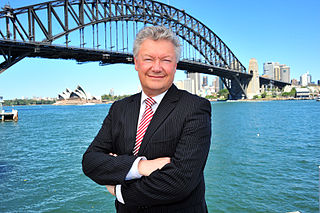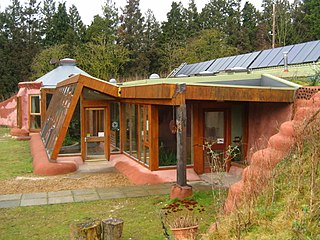Carbon neutrality, or having a net zero carbon footprint, refers to achieving net zero carbon dioxide emissions by balancing carbon emissions with carbon removal or simply eliminating carbon emissions altogether. It is used in the context of carbon dioxide-releasing processes associated with transportation, energy production, agriculture and industrial processes. Carbon-neutral status can be achieved in two ways:

Beddington Zero Energy Development (BedZED) is an environmentally friendly housing development in Hackbridge, London, England. It is in the London Borough of Sutton, 2 miles (3 km) north-east of the town of Sutton itself. Designed to create zero carbon emissions, it was the first large scale community to do so.
The Centre for Alternative Technology (CAT) is an eco-centre in Powys, mid-Wales, dedicated to demonstrating and teaching sustainable development. CAT, despite its name, no longer concentrates its efforts exclusively on alternative technology, but provides information on all aspects of sustainable living. It is open to visitors, offers postgraduate degrees as well as shorter residential and one day courses; and publishes information on renewable energy, sustainable architecture, organic farming, gardening, and sustainable living. CAT also runs education programmes for schools and sells environmentally friendly items through its on site shop, restaurant and mail order department.

A zero-energy building (ZE), also known as a zero net energy (ZNE) building, net-zero energy building (NZEB), net zero building or zero-carbon building is a building with zero net energy consumption, meaning the total amount of energy used by the building on an annual basis is roughly equal to the amount of renewable energy created on the site, or in other definitions by renewable energy sources offsite. These buildings consequently contribute less overall greenhouse gas to the atmosphere during operations than similar non-ZNE buildings. They do at times consume non-renewable energy and produce greenhouse gases, but at other times reduce energy consumption and greenhouse gas production elsewhere by the same amount. A similar concept approved and implemented by the European Union and other agreeing countries is nearly Zero Energy Building (nZEB), with the goal of having all buildings in the region under nZEB standards by 2020.
EcoHomes was an environmental rating scheme for homes in the United Kingdom. It was the domestic version of the Building Research Establishment's Environmental Assessment Method BREEAM, which could also be applied to a variety of non-residential buildings. It was replaced by the Code for Sustainable Homes in April 2008.
Sustainable cities, urban sustainability, or eco-city is a city designed with consideration for social, economic, environmental impact [1][1][1], and resilient habitat for existing populations, without compromising the ability of future generations to experience the same. These cities are inhabited by people whom are dedicated towards minimization of required inputs of energy, water, food, waste, output of heat, air pollution - CO
2, methane, and water pollution. Richard Register first coined the term "ecocity" in his 1987 book, Ecocity Berkeley: Building Cities for a Healthy Future. Other leading figures who envisioned the sustainable city are architect Paul F Downton, who later founded the company Ecopolis Pty Ltd, as well as authors Timothy Beatley and Steffen Lehmann, who have written extensively on the subject. The field of industrial ecology is sometimes used in planning these cities.
Sustainable landscape architecture is a category of sustainable design concerned with the planning and design of outdoor space.
The 2030 °Challenge is an initiative by Edward Mazria and Architecture 2030 asking the global architecture and construction community to adopt a series of greenhouse gas reduction targets for new and renovated buildings.
Ecological design or ecodesign is an approach to designing products with special consideration for the environmental impacts of the product during its whole lifecycle. It was defined by Sim Van der Ryn and Stuart Cowan as "any form of design that minimizes environmentally destructive impacts by integrating itself with living processes." Ecological design is an integrative ecologically responsible design discipline.

The endeavor to use 100% renewable energy for electricity, heating/cooling and transport is motivated by global warming, pollution and other environmental issues, as well as economic and energy security concerns. Shifting the total global primary energy supply to renewable sources requires a transition of the energy system. According to the Intergovernmental Panel on Climate Change there are few fundamental technological limits to integrating a portfolio of renewable energy technologies to meet most of total global energy demand. Renewable energy use has grown more quickly than even advocates anticipated. As of 2019, however, it needs to grow six times faster to limit global warming to 2 °C (3.6 °F).
This page is an index of sustainability articles.

Sustainability is the ability to exist constantly. In the 21st century, it refers generally to the capacity for the biosphere and human civilisation to coexist. Defined also as the process of people maintaining change in a balanced environment, in which the exploitation of resources, the direction of investments, the orientation of technological development and institutional change are all in harmony and enhance both current and future potential to meet human needs and aspirations. For many in the field, sustainability is defined through the following interconnected domains or pillars: environment, economic and social, which according to Fritjof Capra is based on the principles of Systems Thinking. Sub-domains of sustainable development have been considered also: cultural, technological and political. While sustainable development may be the organizing principle for sustainability for some, for others, the two terms are paradoxical. Sustainable development is the development that meets the needs of the present without compromising the ability of future generations to meet their own needs. Brundtland Report for the World Commission on Environment and Development (1987) introduced the term of sustainable development.

Allan Jones MBE, is an engineer who pioneered Combined Heat and Power (CHP), renewable energy and fuel cell systems in the United Kingdom and Australia from 1990 to the present.
All across the world, colleges and universities are looking to a sustainable future by working to become carbon neutral. Universities are taking responsibility for their environmental impact and are working to neutralize those effects. To become carbon neutral, universities are working to reduce their emissions of greenhouse gases, cut their use of energy, use more renewable energy, and emphasize the importance of sustainable energy sources. Universities that have committed to becoming carbon neutral have recognized the threat of global warming and are therefore committing to reverse the trend.
The Living Building Challenge is an international sustainable building certification program created in 2006 by the non-profit International Living Future Institute. It is described by the Institute as a philosophy, advocacy tool and certification program that promotes the most advanced measurement of sustainability in the built environment. It can be applied to development at all scales, from buildings – both new construction and renovation – to infrastructure, landscapes, neighborhoods and communities and differs from other green certification schemes such as LEED or BREEAM.
Environmentally sustainable design is the philosophy of designing physical objects, the sustainability of the world is known as sustainable devalopment
The Queen's Award for Enterprise: Sustainable Development (2006) was awarded on 21 April 2006, by Queen Elizabeth II.
Green urbanism has been defined as the practice of creating communities beneficial to human and the environment. According to Timothy Beatley, it is an attempt to shape more sustainable places, communities and lifestyles, and consume less of the world’s resources. Green urbanism is interdisciplinary, combining the collaboration of landscape architects, engineers, urban planners, ecologists, transport planners, physicists, psychologists, sociologists, economists and other specialists in addition to architects and urban designers.

Earthship Brighton is a self-sustainable building, created in 2006 and owned by the Low Carbon Trust, and situated in Stanmer Park, Brighton.











